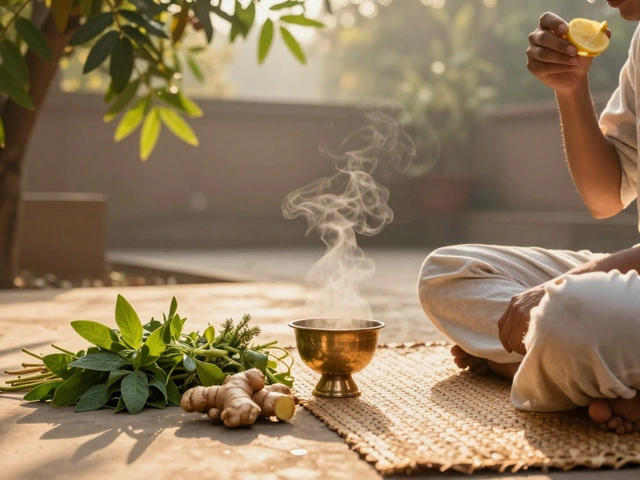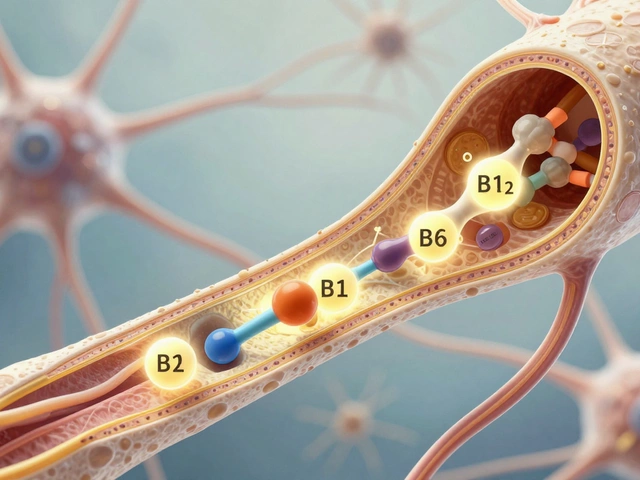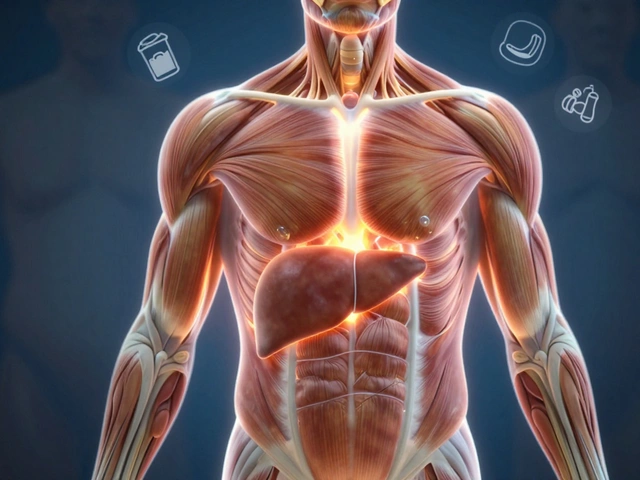Vata Person Traits Quiz
Answer the following questions to discover how much Vata energy is present in your constitution. Each question relates to common Vata traits described in Ayurveda.
Your Vata Score
Vata Traits Overview
Creative
Vata types are highly imaginative and artistic.
Mobile
They tend to move quickly and adapt well to change.
Sensitive
They may feel emotions more deeply and react to stress.
When you hear the term Vata is the airy, mobile dosha in Ayurveda that governs movement, creativity, and the nervous system, you might picture a breezy personality or a light‑bodied frame. That’s close, but there’s more depth. A true vata person reflects a blend of physical, mental, and emotional patterns shaped by this dosha’s unique energy.
Key Takeaways
- Vata is an airy, dry, and cool dosha that drives movement, creativity, and nervous activity.
- Physically, Vata types are often thin, have dry skin, and feel colder than others.
- Mentally, they are quick, imaginative, but can become anxious when ungrounded.
- Typical health issues include joint pain, constipation, and insomnia.
- Balancing Vata involves warm, oily foods, regular routines, and calming practices.
What is Vata?
In Ayurvedic theory, the body is made up of three Doshas (fundamental bio‑energetic forces that regulate physiology and personality. Vata, Pitta, and Kapha each combine the five elements in different ratios. Vata is primarily air and ether, making it light, dry, and mobile. It governs all motion: breathing, circulation, nerve impulses, and even thoughts.
Physical Traits of a Vata Person
Because Vata is the motion‑maker, a Vata‑type body tends to be slender and flexible. Typical signs include:
- Thin, often lanky build with long limbs
- Dry, flaky skin and hair that can be fine or brittle
- Cool body temperature; they feel chilly even in warm rooms
- Variable appetite; they may eat a lot one day and barely anything the next
- Quick metabolism that can lead to weight fluctuation
These physical cues are clues that Vata’s airy energy is dominant.
Mental and Emotional Patterns
Vata’s element of air also drives the mind. Vata people are often:
- Sharp and quick thinkers, able to generate ideas on the fly
- Highly creative, gravitating toward arts, writing, or innovation
- Easily distracted; focus can flicker like a wind‑blown leaf
- Prone to anxiety, worry, or nervousness when routine breaks
- Emotionally sensitive, feeling highs and lows more intensely
When Vata is balanced, these traits fuel inspiration. When out of sync, the same mind can become restless and overwhelmed.
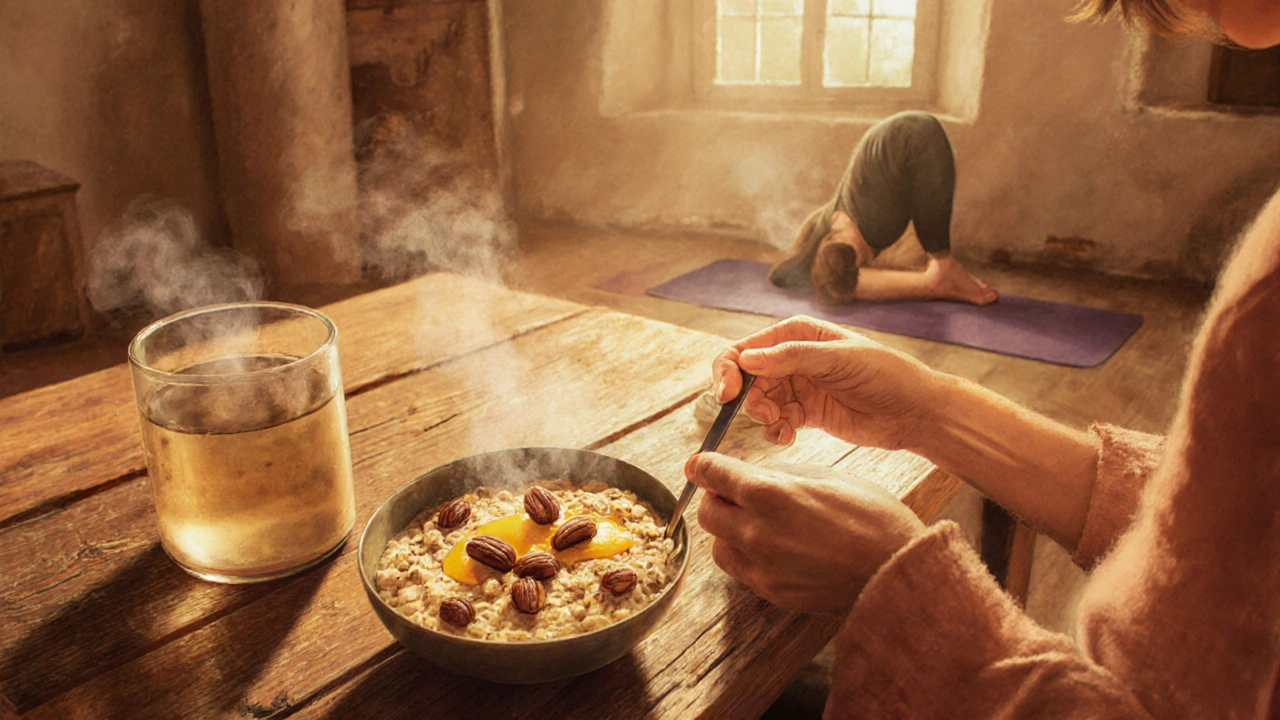
Common Health Tendencies
Each dosha carries typical health patterns. For Vata, the main concerns stem from its dry, cold nature and its role in movement:
- Joint pain (especially in the knees, wrists, and lower back) due to insufficient lubrication
- Constipation and dry stools, reflecting the dry quality of the dosha
- Insomnia or light sleep, because Vata keeps the nervous system active
- Anxiety, nervousness, and occasional panic attacks
- Skin conditions like eczema or cracked lips that thrive in dry environments
Understanding these tendencies allows a Vata person to catch imbalance early and act preventively.
Balancing Vata: Diet, Lifestyle, and Daily Routine
Balancing Vata is all about grounding the airy energy with warmth, moisture, and stability. Here are practical steps:
- Warm, cooked foods: Favor soups, stews, cooked grains (rice, oatmeal), and warm milk. Add spices like ginger, cinnamon, and cumin to generate heat.
- Oily ingredients: Use ghee, olive oil, or sesame oil liberally. These counteract dryness.
- Regular meals: Eat at consistent times, ideally breakfast and dinner by 7pm to keep the digestive fire (Agni (the metabolic fire that digests food and transforms nutrients) stable.
- Hydration: Sip warm water throughout the day; avoid icy beverages.
- Grounding routine: Wake up and go to bed at the same hour daily. A calming evening ritual-like chamomile tea, gentle yoga, or meditation-helps settle the mind.
- Physical activity: Choose steady, grounding exercises such as walking, swimming, or yoga. Avoid overly vigorous cardio that can aggravate the nervous system.
- Massage: Regular Abhyanga (self‑oil massage) using warm sesame oil improves circulation and reduces joint dryness.
When Vata aligns with supportive habits, the mind feels clearer, the body steadier, and the energy balanced.
Vata vs. Pitta vs. Kapha: Quick Comparison
| Aspect | Vata | Pitta | Kapha |
|---|---|---|---|
| Primary Elements | Air & Ether | Fire & Water | Earth & Water |
| Physical Build | Thin, light, lanky | Medium, muscular, sharp | Heavy, solid, broad |
| Skin/Hair | Dry, flaky, fine | Warm, oily, prone to acne | Thick, oily, smooth |
| Temperament | Creative, adaptable, anxious | Goal‑oriented, fiery, irritable | Calm, steady, sluggish |
| Common Ailments | Joint pain, constipation, insomnia | Acid reflux, inflammation, skin rashes | Weight gain, congestion, lethargy |
| Balancing Foods | Warm, oily, moist (soups, cooked grains) | Cooling, sweet, slightly bitter (cucumbers, cilantro) | Light, dry, bitter (leafy greens, spices) |
Seeing the contrast helps a Vata person identify what feels off and what can bring harmony back.
Signs of Vata Imbalance and Simple Remedies
When Vata goes out of whack, the body shows clear signals. Look for these red flags:
- Restlessness, racing thoughts, or chronic worry
- Feeling cold all the time, especially in the hands and feet
- Dryness in skin, hair, or nails
- Irregular digestion: gas, bloating, constipation
- Joint stiffness or occasional sprains
Quick remedies:
- Drink a cup of warm ginger‑lemon water first thing in the morning.
- Apply warm sesame oil to joints after a warm shower.
- Increase intake of cooked root vegetables (sweet potatoes, carrots).
- Incorporate a daily grounding practice-like mindful breathing for five minutes.
- Sleep with a light blanket and avoid heavy, synthetic fabrics.
These steps won’t cure chronic issues but can stabilize Vata on a day‑to‑day basis.
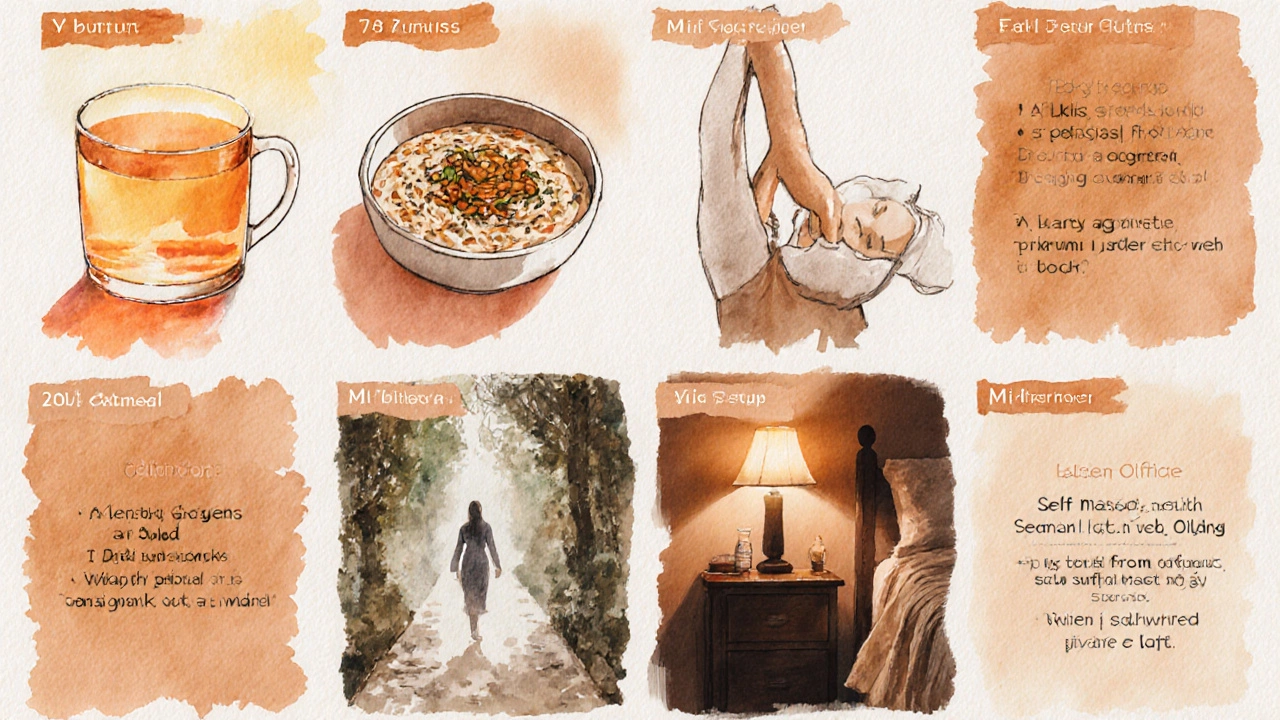
Understanding Your Ayurvedic Constitution (Prakriti)
Every individual has a unique Prakriti (the innate blend of doshas you’re born with). For many, Vata is dominant, but most people have secondary influences from Pitta or Kapha. Knowing your exact mix helps you fine‑tune your lifestyle. If you’re 70% Vata, 25% Pitta, 5% Kapha, the Vata recommendations will be strongest, but you’ll also want to watch Pitta‑related inflammation.
Connecting Vata to the Body’s Channels (Srotas)
Ayurveda describes Srotas (the bodily channels that transport nutrients, waste, and energy). Vata primarily flows through the nervous, muscular, and respiratory Srotas. When these pathways clog with Ama (toxic, undigested residue that forms from weak Agni), Vata symptoms intensify. Keeping the digestive fire strong and the channels clear is essential for a balanced Vata constitution.
Putting It All Together: A Sample Day for a Vata Person
Here’s a realistic routine that incorporates diet, movement, and mindfulness:
- 6:30am - Warm ginger water; gentle stretching for 10 minutes.
- 7:30am - Warm oatmeal with ghee, raisins, and a pinch of cinnamon.
- 10:00am - Light snack: a handful of soaked almonds.
- 12:30pm - Lunch: cooked quinoa, sautéed carrots, zucchini, and a spoonful of sesame oil.
- 3:00pm - Herbal tea (licorice or chamomile); short walk.
- 6:30pm - Dinner: warm lentil soup with ginger, turmeric, and a side of steamed broccoli.
- 8:00pm - Abhyanga self‑massage with warm sesame oil.
- 9:30pm - Calm meditation or reading; lights dimmed.
- 10:30pm - Bedtime, ensuring the room is warm and cozy.
Sticking to such a rhythm keeps Vata calm, nourished, and grounded.
Frequently Asked Questions
How can I tell if I’m a Vata dominant person?
Look for a thin frame, dry skin, a tendency to feel cold, quick mental activity, and a preference for warm, moist foods. If most of these signs match, Vata likely dominates your constitution.
Can a Vata person be athletic?
Absolutely. Vata excels in activities that require flexibility and endurance like yoga, swimming, or long‑distance cycling. The key is to avoid overly high‑impact or sprint‑type sports that can overstimulate the nervous system.
What foods should a Vata person avoid?
Cold, raw, and dry foods increase Vata imbalance. Skip ice‑cold drinks, salads with raw cruciferous vegetables, and excessive caffeine. Also limit fried or overly spicy dishes that can aggravate the nervous system.
Is it possible to have a balanced Vata all year round?
Seasonal shifts affect Vata. During fall and winter, Vata naturally rises, so extra warm foods and routines are needed. In spring and summer, lighter meals and a bit more activity keep Vata steady. Adjusting habits with the seasons makes year‑round balance realistic.
How does Vata relate to stress?
Because Vata governs the nervous system, stress can quickly tip it into over‑activity. Practices like deep‑breathing, grounding meditation, and regular sleep schedules calm the Vata nerves and reduce stress‑induced symptoms.






